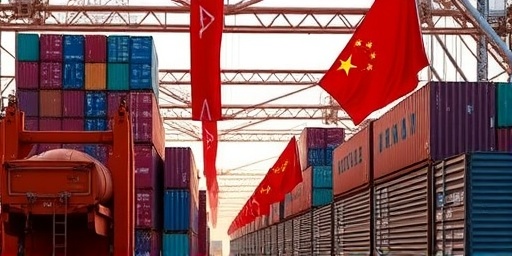In a bold move signaling a potential revival of protectionist policies, President-elect Donald Trump has proposed imposing 60% Tariffs on China imports, sending shockwaves through Wall Street and igniting concerns over a renewed trade war. Announced during a recent interview, the plan targets a wide array of goods from electronics to apparel, prompting immediate sell-offs in tech and manufacturing stocks. Economists are sounding alarms about skyrocketing consumer prices and widespread supply chain disruptions, as markets grapple with the specter of escalating global tensions.
Wall Street Plunges as Tariff Fears Grip Investors
The financial markets reacted swiftly to Trump’s tariff proposal, with the Dow Jones Industrial Average dropping over 300 points in early trading following the announcement. Tech giants like Apple and Nvidia, heavily reliant on China imports for components and assembly, saw their shares tumble by 4% and 5.2% respectively. Manufacturing bellwethers such as Boeing and Caterpillar also faced sharp declines, losing up to 3.8% in value as investors braced for higher costs and retaliatory measures from Beijing.
Analysts attribute the volatility to the sheer scale of the proposed Tariffs, which dwarf the 25% duties imposed during Trump’s first term. ‘This isn’t just rhetoric; it’s a direct threat to corporate profitability,’ said Sarah Jenkins, chief economist at Goldman Sachs. ‘Supply chain dependencies on China mean these Tariffs could add billions in unforeseen expenses, eroding margins across sectors.’ Trading volume surged by 25% above average, reflecting heightened investor anxiety over a potential trade war that could stifle economic growth.
Broader indices felt the pinch too. The S&P 500 dipped 1.2%, while the Nasdaq Composite fell 1.8%, underscoring the tech sector’s vulnerability. Currency markets were equally turbulent, with the U.S. dollar strengthening against the yuan by 1.5%, as traders anticipated a slowdown in bilateral trade. Hedge funds and institutional investors are reportedly reallocating portfolios, favoring domestic-focused assets while shorting import-heavy companies.
Economists Forecast Higher Inflation and Supply Chain Chaos
Experts are unanimous in their warnings that Trump’s tariffs could reignite inflationary pressures not seen since the pandemic era. The Peterson Institute for International Economics estimates that a 60% levy on China imports—valued at over $500 billion annually—could raise U.S. consumer prices by 2-3% within the first year. Everyday items like smartphones, clothing, and toys, which constitute a significant portion of these imports, would bear the brunt, potentially adding $1,200 to the average household’s annual spending.
Supply chain disruptions loom large, with companies already scrambling to diversify sourcing. ‘The last trade war exposed vulnerabilities in global logistics; this could amplify them exponentially,’ noted Dr. Michael Chen, a supply chain specialist at MIT. Firms like Walmart and Target, which source 70-80% of their merchandise from China, have begun stockpiling inventory, but experts predict delays and shortages if tariffs take effect. A recent survey by the U.S. Chamber of Commerce revealed that 62% of manufacturers anticipate production halts due to cost hikes.
Inflationary ripple effects could extend to services and wages. As businesses pass on tariff costs, economists like those at the Federal Reserve warn of a wage-price spiral, complicating the central bank’s efforts to tame post-pandemic inflation hovering around 3%. Quotes from industry leaders underscore the urgency: Ford Motor Company’s CEO Jim Farley stated, ‘Tariffs of this magnitude would disrupt our just-in-time manufacturing model, forcing us to rethink entire supply chains overnight.’
To illustrate the potential impact, consider the electronics sector: Semiconductors from China, critical for everything from cars to medical devices, could see prices rise 40%, according to a report from the Semiconductor Industry Association. This not only affects consumers but also hampers U.S. competitiveness in high-tech industries.
Echoes of the 2018 Trade War Resurface in Policy Debates
Trump’s latest tariff salvo evokes memories of the 2018-2019 trade war, when duties on $360 billion in China imports led to retaliatory tariffs and a 0.3% drag on U.S. GDP, per the Congressional Budget Office. Back then, agricultural exports plummeted by 20%, necessitating $28 billion in federal bailouts for farmers. Now, with the proposal at 60%, the stakes are even higher, potentially costing the economy up to $1.2 trillion over five years, according to Moody’s Analytics.
Political reactions are polarized. Supporters, including Trump’s transition team, argue the tariffs will protect American jobs and reduce the trade deficit, which stood at $419 billion with China in 2023. ‘It’s time to bring manufacturing home and level the playing field,’ Trump declared in his interview. Critics, however, including bipartisan lawmakers, decry the move as reckless. Senate Minority Leader Chuck Schumer called it ‘a recipe for economic self-sabotage,’ warning of alienated allies and empowered adversaries.
Historical precedents abound. During the first trade war, U.S. soybean exports to China fell 74%, devastating Midwest farmers. Today, with global supply chains more intertwined, the fallout could be global. The World Trade Organization has already flagged potential violations of trade rules, which might invite disputes and further escalation.
- Key 2018 Impacts: U.S. manufacturers lost $46 billion in exports due to retaliation.
- Current Risks: Broader tariffs could affect 15% of U.S. GDP tied to international trade.
- Policy Shifts: Trump’s team hints at exemptions for allies like Mexico, but details remain vague.
As debates intensify, think tanks like the Brookings Institution are modeling scenarios where a full-blown trade war shaves 1.5% off global growth, hitting emerging markets hardest.
Tech and Manufacturing Sectors Face Dire Supply Chain Overhauls
The tech industry, a cornerstone of U.S. innovation, stands at the epicenter of tariff-induced turmoil. Companies like Intel and Qualcomm depend on China for rare earth minerals and assembly lines, with 90% of global smartphone production occurring there. A 60% tariff could inflate iPhone prices by $100-200 per unit, per analyst estimates from Wedbush Securities, potentially curbing demand and slowing the sector’s 7% annual growth rate.
Manufacturing faces similar headwinds. The auto industry, already strained by chip shortages, could see vehicle prices rise 10%, according to the Alliance for Automotive Innovation. General Motors has invested $7 billion in U.S. plants to mitigate risks, but executives warn that sudden tariffs would overwhelm these efforts. ‘Our supply chain is a web; pulling one thread unravels the whole,’ said GM’s supply chain VP, Lisa Boyd.
Smaller firms are particularly vulnerable. A National Association of Manufacturers poll shows 55% lack the capital to relocate operations, risking bankruptcies. Onshoring initiatives, like the CHIPS Act’s $52 billion infusion, offer hope, but implementation lags behind tariff threats. Quotes from affected CEOs highlight the human cost: ‘These policies could idle factories and put thousands out of work,’ lamented the head of a Midwest steel producer.
- Immediate Actions: Companies are accelerating diversification to Vietnam and India.
- Long-Term Challenges: Rebuilding domestic capacity could take 5-10 years and trillions in investment.
- Sector-Specific Hits: Apparel imports, 40% from China, may see 20% price hikes.
Amid these pressures, innovation hubs in Silicon Valley are pivoting toward AI-driven supply chain optimizations, but the transition won’t be seamless.
International Allies and Rivals Prepare for Trade War Ripples
Beyond U.S. borders, Trump’s tariffs are prompting a cascade of responses. China, the world’s second-largest economy, has vowed countermeasures, including restrictions on rare earth exports vital for U.S. defense and renewables. Beijing’s commerce ministry labeled the proposal ‘economic coercion,’ hinting at tariffs on American aircraft and soybeans worth $15 billion.
European allies, wary of being caught in the crossfire, are urging de-escalation. The EU, which faced its own China duties in 2018, has boosted trade talks with Washington to avoid collateral damage. ‘A U.S.-China trade war would disrupt global supply chains, raising costs for everyone,’ said Ursula von der Leyen, European Commission President.
In Asia, nations like South Korea and Japan—key players in electronics—are fortifying ties with the U.S. through frameworks like the Indo-Pacific Economic Framework. Meanwhile, Mexico could benefit as a nearshoring hub, with Ford and Tesla expanding operations there to bypass China imports. However, experts caution that fragmented supply chains might increase overall inefficiencies by 15%, per a McKinsey report.
Looking ahead, the tariffs’ fate hinges on Trump’s inauguration in January and congressional approval. If enacted, they could reshape global trade dynamics, forcing a reevaluation of WTO norms and bilateral deals. Policymakers are eyeing phased implementations to minimize shocks, but uncertainty persists. As one trade expert put it, ‘This could mark the end of globalization as we know it, ushering in an era of regional blocs and heightened protectionism.’ Investors and businesses alike are monitoring Capitol Hill closely, preparing for a landscape where supply chain resilience becomes paramount and trade wars define economic policy.









